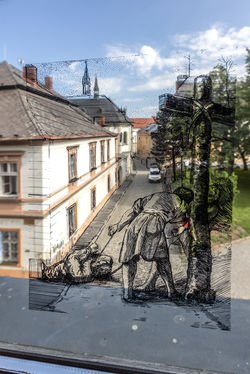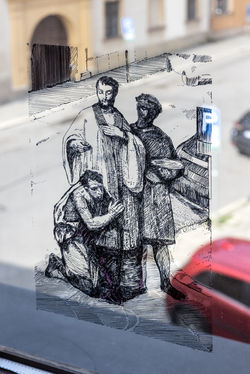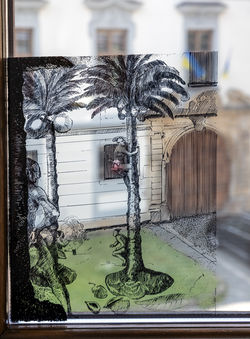Jaro Varga
RETURN TO THE NEW WORLD
2022
site specific project at The Library of Palacký University in Olomouc, Czech Republic, 2022
in collaboration with Olomouc Modern of Art
photo:Olomouc Modern of Art
Jaro Varga created a project for the Palacký University Library in Olomouc that could be summarized as "One World is not Enough". He himself calls it "Return to the New World" and tries to remind us of the dimension that our thinking about it generally has. In doing so, he turns to the history of the Jesuit Order, to its missionary activity, to the ways in which – as the first of the truly global initiatives – It defined and reformed the proverbial New World, precisely as essentially twofold. Equally, however, it also reflects the original “home” and the purely local context – Olomouc as a university town, i.e., a Jesuit town, because it was the Jesuits who administered the local college in its crucial period. And it places the stories they wrote about in their letters to Bohemia, as well as the engravings and paintings that local artists created based on them to bring the New World closer to the Old, in the axes of local streets, among local houses and corners. The cycle of ten small drawings he made on the windows of the Theresian Armoury (sic) is the eye of the needle through which we pass between the past and the present, between “our” and “the foreign”. It is a representation of ancient convictions and decisions, but it forces us to think not only about their historical validity. The world has rapidly shrunk over the last few decades, becoming more fragile and less secure, as have our interpretations of what is right or good. Perhaps that is why it makes so much sense to ask: What does it mean to appeal to the universe and take personal responsibility for it?
The Jesuit order, the Society of Jesus, was founded in 1534 on the initiative of the Basque reformer Ignatius of Loyola (1491-1556). The Jesuits settled in Prague in 1556 and in Olomouc ten years later. Between 1576 and 1773 they were responsible for higher education here – after years spent in the Old Convent, which was located next to the Church of Our Lady of the Snows, they built the New Convent in 1717, today's Art Centre of Palacký University with the Chapel of the Corpus Christi. Education was the main instrument of the recatholization that was undertaken in the Czech environment after the Battle of White Mountain. It was also a significant limitation of their missionary activity. Their extensive knowledge of mathematics, cartography, geography, and astronomy helped them to fulfil the saying “The Word is the Sword” and thus participate in the first wave of globalisation. Although the first photograph of the Blue Planet dates to 1968, the Jesuits had been dealing with the totality of the universe imaginatively, in symbols and semantics, since the end of the 16th century. Hence the phrase Unus non Suficit Orbis (One World is Not Enough), reflecting the duality of the worlds we inhabit or aspire to – the earthly and the afterlife, the inner and the outer, or the old and the new. It was the New World, the overseas world returning to the hands of God through missionary work, that the Jesuits considered the basis of their activity. It was also here that they found the opportunity to achieve salvation by their own works and efforts. In a remarkable way, the preconditions of the revolutionary concept of the private Exercise, one of the fundamental innovations of Jesuit piety, were thus fulfilled, enabling not only those who are predestined by nature to reach enlightenment. The topography of enlightenment, the understanding of life as a kind of pilgrimage, finds its reflection precisely in the missionary activity of the Jesuits and the topoi of the good death that is associated with the purposeful fulfilment of missionary practice. The physical nature of the Jesuit spiritual experience, involving the capacity for the sensory suggestion, tends to unite what appears with what lies behind it. Hence the relation to the earth as a material entity can be explored – and through this exploration, approach its essence, the divine ideal. Hence the writings of the Olomouc Jesuit Valentín Stansel (1621-1705), who, during his stay in Brazil, wrote a treatise on travels into space. But there was also a reciprocal appropriation of the outside world, in word and image, which resulted in the development of a colonising practice, the consequences of which we are still dealing with today – in Olomouc as much as in London or Barcelona. Decolonisation, as one of the most widely used terms in contemporary critical practice, is itself a complex process, and its internal contradictions should not be underestimated. Indeed, what previously appeared as the ultimate instrument of usurpation, i.e., Jesuit cartography, is now often a testament to the original ethnic diversity of the “new” New World. (Barbora Kundračíková)
Jaro Varga's project “Return to the New World” was created as part of the SEFO Triennial Universum organized by the Olomouc Museum of Art in 2021.
curated by Barbora Kundračíková
Descriptions
1/ Jesuit preaching to the natives – copperplate frontispiece, 1693
Thomas Gage continued the family tradition and received a Jesuit education, but eventually joined the Dominican Order and between 1625 and 1673 he travelled and lived in Mexico and Guatemala respectively. A print published by Johann Herbordt Kloss in Leipzig in 1693 seems to depict the moment when Native Americans bring gifts to a missionary, probably Thomas Gage himself.
"Tobacco leaves serve in place of money, with which we can buy food or arrange for tenants. One must beware of being stingy with them. They themselves distribute whatever they have generously among others, and therefore there is not a single beggar among them. Whoever goes anywhere among them need not take any provisions, for wherever he goes he is received and fed in a friendly manner. It is indeed a strange thing: if anyone gets something to eat, and if others are present, he does not eat it himself but immediately shares it with the others. This habit is acquired by young children. But there is another strange thing, which makes one almost unhappy, for it smacks of ingratitude. If you give anything to someone that he himself would not ask for, they do not see it as a favour. They only feel obliged for what they have received when they themselves have asked for it." (Jan Tilpe)
Pavel Zavadil, Čeští jezuité objevují nový svět, Dopisy a zprávy o plavbách, cestách a živobytí z Ameriky, Filipín a Marián (1657-1741), Praha 2015
2/ Scene depicting a catechism lesson at the mission, painted by the Czech Baroque portraitist Jan Jiří Heinsch (1674-1712) from Prague, a pupil and follower of Karel Škréta
"In the morning at dawn almost all the Indians come together, and we say the service. After it, we pray aloud and then follow the inquiry into the fundamental mysteries of the faith. Then I dismiss the adults and teach the children the catechism for about two hours. After lunch, there is a reading and singing school. Before dark, everyone, including the adults, gathers and says the usual prayers." (Jan Gintzel)
Petr Zavadil, Čeští jezuité objevují nový svět, Dopisy a zprávy o plavbách, cestách a živobytí z Ameriky, Filipín a Marián (1657-1741), Praha 2015
"I immediately set about the education of the children, and every day since my arrival I have gathered them twice in the church. In the morning after Mass, I said the Hail Mary with them, I believe in God, the Ten Commandments, the sacraments of the Church... The rest of the day we spent visiting the sick, confessing sinners (I have few of them so far)."
Petra Kubíčková – Lubomír Novotný, Ad Gloriam Dei, Moravští misionáři v 16.-18. století, Olomouc 2013
3/ Depiction of a Jesuit mission – a missionary giving the Bible to a native
The illustration was published in The New Eclectic History of the United States by M. E. Thalheimer (American Book Company; New York, Cincinnati and Chicago) in 1881 and 1890.
"It is our duty to convert the heathen to the faith and baptize them, to establish missionary settlements, and to bring the Indians from their scattered caves and huts to live in accordance with laws and rules, to gather them into one place, to bring them to establish villages around the churches we build in conspicuous and accessible places, and to live in them." (Josef Neuman)
Pavel Zavadil, Čeští jezuité objevují nový svět, Dopisy a zprávy o plavbách, cestách a živobytí z Ameriky, Filipín a Marián (1657-1741), Praha 2015
4/ A contemporary engraving by the Czech graphic artist Johann Balzer (1738-1799) depicting the torture of the missionary Augustin Strobach on the Marian Island of Tinian in 1684
Augustin Strobach was consecrated in 1674 by Bishop Breuner of Olomouc. From 1681 he was on missionary journeys, first in Veracruz, and later in the Philippine and Marianas Islands. In his letters, he stresses the nobility of the natives, who had come up hard against the culture of Western man: "These generous people at first thought that everyone was as noble as they were, and therefore they were very angry with the Christians when the latter denied them what they desired, considering them to be ill-mannered barbarians to whom love meant nothing." In 1984 a revolt of the natives broke out, in which Augustine Strobach died. His death is described by his comrade Kukulín: "(...) in his anger he tore the cross from his throat and would have crushed it between two stones if another pious Marian had not asked him for the cross (...) From there he was taken to the village with his hands tied... and he was brought before another of the chief Indians there (...) saying he stretched out his hand with a club to strike him a blow, and struck him with such force in the throat that the stricken man almost immediately afterwards died in holy death."
Petra Kubíčková – Lubomír Novotný, Ad Gloriam Dei, Moravští misionáři v 16.-18. století, Olomouc 2013
5/ Period engraving depicting indigenous people in the Jesuit reduction in Paraguay
"The reductions were incorporated with some autonomy into the Spanish colonial empire and were intended to bring the population to a settled life in a society with a division of labour in their own small towns and to lead this population to the Christian faith. The Jesuits created a very sophisticated model of society that addressed issues of economics (division of labour, production of daily necessities, cultivation of crops), religion and culture. One of the basic principles of the functioning of the reductions was common ownership. The individual farms were independent of the Spanish colonial administration, which earned them the comparison to a state within a state."
Petra Kubíčková – Lubomír Novotný, Ad Gloriam Dei, Moravští misionáři v 16.-18. století, Olomouc 2013
6/ Baroque engraving depicting the martyrdom of Jesuit Corneille Beudin in Tarahumara in 1650
In the original engraving, pagodas in the East Asian style appear in the background of the scene, which is the free invention of Karel Škréta. Changes and distortions of the background and their adaptation to the expectations of the European eye are common in contemporary engravings.
"The Rector of the New or Upper Tarahumara Missions, the aforementioned Father Tomas de Guadalajara, who resides in the Indian village of St. Raphael (otherwise Matachi) and looks after the northernmost of our missions towards New Mexico, has noticed some changes among his Indians. They have ceased to obey the Father's commands, they have ceased to participate in the exposition of Christian doctrine as abundantly as formerly, and they have ceased to do their duty to the Father. Instead, they held numerous drinking parties at night, even before the Father's eyes. Some carried the harvest from the fields to safe hiding places far away in the mountains, while others produced large quantities of spears and arrows. The chief no longer wanted to punish the guilty. The father, who was, moreover, constantly troubled by failing health and violent attacks of disease, began to doubt the fidelity of his Indians and the safety of his life. Moreover, two Indians from other tribes who had lived with the Father had allegedly overheard some talk that a plot was afoot to kill him because the Indians wanted to return to their old uninhibited life." (Josef Neuman)
Pavel Zavadil, Čeští jezuité objevují nový svět, Dopisy a zprávy o plavbách, cestách a živobytí z Ameriky, Filipín a Marián (1657-1741), Praha 2015
7/ A print depicting the French Jesuit missionaries Jean and Jacques de Lamberville
From 1669 to 1710, Jean and Jacques de Lamberville served a mission among the native Onondaga Iroquois tribe in the French colonies in North America. They had to leave the mission because of the intrigues of Abraham Schuyler, who incited drunken natives to burn the chapel and the priest's residence. The engraving is from Cassell's History of the United States by Edmund Ollier, published in 1880.
"Then he (the Father), through the Indian chiefs, had the whole tribe convened and had all who had organized or participated in the drinking punished by whipping, the usual mode of punishing Indians. Among those punished was the chief of my mission as the primary cause of the drinking." (Josef Neuman)
"After learning from the Fathers in the mountains of the developments there, I was cautious and went on my errands accompanied by Indians I could trust. When I later learned how the whole thing had turned out I made my Indians afraid - in case they wanted to be unfaithful to me as well. I threatened that I should also have to call out Spanish troops against them, although in Upper Tarahumara this would not be so easily done, as we were under another governor, that of the kingdom of New Biscay." (Josef Neuman)
Pavel Zavadil, Čeští jezuité objevují nový svět, Dopisy a zprávy o plavbách, cestách a živobytí z Ameriky, Filipín a Marián (1657-1741), Praha 2015
8/ Baptism – period engraving
"The overzealous missionaries, who in the course of three years sought out six thousand animal souls in the mountains, brought them to six settlements which they founded and conferred on them the sacrament of baptism." (Josef Neumann)
Pavel Zavadil, Čeští jezuité objevují nový svět, Dopisy a zprávy o plavbách, cestách a živobytí z Ameriky, Filipín a Marián (1657-1741), Praha 2015
9/ Fruits of the East Indies, described also by Czech Jesuits – illustration from the travelogue of Dutch merchant Huyghen van Linschoten (1563-1611)
"Most of them are tall, muscular and plump. They walk completely naked, only the women cover at least the more secret places with a leaf from a tree. Thank God, since they are Christians, they require and use clothing, at least when they go to church or to visit us. But they don't generally wear them in their homes, much less at work. They are a people accustomed to continuous bathing, and I would say that a good third of their lives are spent in water" (Jan Tilpe)
Pavel Zavadil, Čeští jezuité objevují nový svět, Dopisy a zprávy o plavbách, cestách a živobytí z Ameriky, Filipín a Marián (1657-1741), Praha 2015
10/ Copperplate with a depiction of a Jesuit blessing a church in New England and Maryland from 1643 - listed in the Societas Jesu edition under the title Sudoremet mortem, Pro Salute Proximi laborans (Matthew Tanner), probably engraved by the German engraver Jeremias Kilian (1665-1730)
"Newborns are carried immediately to be baptized, the sick are brought to the church to receive the last sacraments, and when this is impossible because of the weakness of the sick, they call the Father, who comes in person. They no longer laugh at their old superstitions themselves, and, on the contrary, they value the truth which, with the help of God, they know better and better." (Jan Tilpe)
Pavel Zavadil, Čeští jezuité objevují nový svět, Dopisy a zprávy o plavbách, cestách a živobytí z Ameriky, Filipín a Marián (1657-1741), Praha 2015
 |  |
|---|---|
 |  |
 |  |
 |  |
 |  |